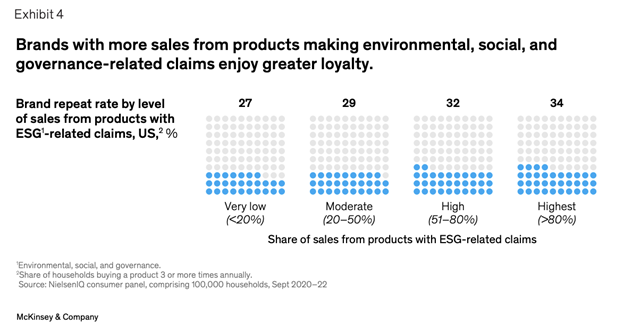In an era where environmental sustainability matters more than ever, there is a global shift in customer preferences. Customers, especially younger generations, increasingly favor companies that champion environmentally friendly practices. In turn, seeking loyalty programs that represent those values and priorities.
Environmentally friendly loyalty programs incorporate sustainability into their core. These programs encourage customers to make greener choices through rewards and incentives and very often tie loyalty benefits to eco-friendly purchases and other sustainable actions.
Such reward programs can range from planting trees to offering reusable products to returning lightly used goods to the brand as part of loyalty initiatives. Statistics show that 87% of consumers have a more positive image of a company that supports social or environmental issues [1]. Adopting an environment-first loyalty program either as a core component or standalone mission is both a timely and wise business decision.
3 Major Benefits of Creating an Environmentally Friendly Loyalty Program
Creating an environmentally friendly loyalty program has numerous tangible and intangible benefits. Here are three of the most important:
- Increased Customer Loyalty: A well-designed green loyalty program can significantly enhance customer loyalty. According to a 2020 study by Accenture, 41% of consumers report loyalty to brands that offer environmentally friendly products.
- Increased Product Value & Potentially Better Margin on Goods Sold: An environmentally friendly loyalty program can elevate a brand’s image. A Nielsen report reveals that 66% of global consumers are willing to pay more for sustainable goods.
- Reduced Operating Expenses: Promoting sustainable practices through a loyalty program can also help cut costs. The US Environmental Protection Agency (EPA) reports that energy-efficient business operations have yielded up to 30% savings.
Examples of Environmentally Friendly Loyalty Programs
There are many businesses that have integrated sustainable loyalty programs focused on environmental objectives to achieve impressive results. The following illustrates the power and potential of responsive, eco-friendly strategies in creating lifelong customer relationships.
The Girlfriend Collective
The Girlfriend Collective is a brand that produces eco-friendly fitness apparel. Their environmentally friendly loyalty program, the “ReGirlfriend” Program, offers customers points for returning old Girlfriend Collective clothing, enabling effective recycling.
The program’s motto is “Good Things Come To Those Who Don’t Waste.” Its success is showcased through its positive environmental impact and increased customer loyalty, allowing the Girlfriend Collective to maintain sustainability and customer engagement [2].
Tentree
Tentree is a sustainable retail company known for selling eco-friendly clothing. Customers love this brand because sustainability is at the heart of everything they do, from ethically sourced products and responsible packaging to their proprietary loyalty program called the “Impact Wallet.” The exceptional loyalty program effectively engages customers in climate-positive action.
Using Tentree’s Impact Wallet, customers can see what trees they’ve planted with their purchases, where those trees are planted, and how the trees are helping the planet. This strategy increased customer involvement, boosted sales and generated vital environmental impacts [3].
Patagonia
Patagonia, a well-known outdoor clothing company, has always included sustainability throughout its business. Their “Worn Wear” program encourages customers to repair, reuse, and recycle their products. This program has created deeper trust in the brand, boosted customer loyalty and elevated engagement.
Patagonia’s success lies in its commitment to repairing products for free and offering second life to clothes through trade-ins. Not only has this created success for the brand, but it has also contributed significantly to a reduced environmental footprint [4].
Etihad Airways
Etihad Airways, the national flag carrier of the UAE, is a leading global airline. The airline initiated an environmentally friendly loyalty program called “Etihad Guest.” The program focuses on environmental sustainability, offering carbon offset options to its loyal members [5].
Etihad partners with CarbonClick to offer customers carbon offsetting. CarbonClick is a company out of New Zealand that aids over 650 businesses and 38,000 individuals in climate action. The airline is among the first to collaborate on climate solutions.
Madewell
Madewell is a renowned American denim brand prized for its durable and trendy jeans. Their commitment to sustainability is reflected in their successful “Blue Jeans Go Green” loyalty program. For each pair of recycled jeans members donate, they receive $20 off their next denim purchase [6].
Key Tactics To Creating Successful Eco-Friendly Loyalty Programs
Creating personalized reward systems that offer unique experience-based perks, authentic recognition and deep appreciation are key to creating lifelong customers.
Continuous engagement and feedback mechanisms are vital to customer loyalty programs. Using data analytics, brands can better understand customer behavior and tailor those loyalty programs to motivate repeat purchases.
The following are some examples of these tactics in action.
Digital Loyalty Cards
Introducing digital loyalty cards is a future-forward tactic for environmentally friendly loyalty programs. They bridge the gap between the brand and consumers, fostering customer retention.
For example, Starbucks has found incredible success with its digital loyalty app, allowing customers to order before they arrive to skip busy lines and earn points towards new orders. Starbucks attributes 40% of its total sales to the Rewards Program, with same-store sales seeing a rise of 7%.
The company uses digital rewards to give customers the opportunity to earn ‘stars’ on purchases. Customers who already love Starbucks are further incentivized to return and rewarded well. Customer loyalty for the brand skyrockets (as well as Starbucks’ revenues).
Encourage Members to Reuse and Recycle
Encouraging customers to reuse and recycle promotes sustainable practices. It cultivates a strong brand image and demonstrates a commitment to environmental consciousness, creating a bond and lifelong loyalty with like-minded customers.
Similar to Patagonia’s “Worn Wear” program, a brand might offer repairs to customers or provide exclusive rewards for returning used products for recycling. These types of programs show creative initiative and incentivize customers to engage frequently and create a sustainability loop within the brand.
Cash-rounding
Cash-rounding is a popular tactic for creating environmentally friendly loyalty programs. This method eliminates the need for small change, simplifying transactions for customers and businesses. Brands can use this concept for customers’ gratification, rounding up their total purchase to the nearest dollar.
Rounding up increases the price of each transaction by $0.50 (on average) + a $0.50 donation. The surplus could be converted into loyalty points, which eases transactions and retains customers by rewarding purchases.
One Purchase Equals One CSR Action
One purchase = one CSR (Corporate Social Responsibility) action is a unique incentive for brands striving for viable loyalty programs. This tactic has dual benefits. Customer loyalty through direct involvement in corporate philanthropy and brand sustainability via societal contribution.
TOMS Shoes famously used this strategy – every purchase translates into a pair of shoes for children in impoverished communities. This buy-one, give-one approach builds customer loyalty while establishing a socially responsible reputation.
Give Customers Trees as Gifts
Gifting trees to customers promotes environmental sustainability. It creates an impression of a responsible brand that cares about global challenges. This meaningful gesture fosters customer loyalty and improves brand image.
Imagine a clothing brand offering to plant a tree for every product sold. Over time, customers will admire this initiative, leading to positive perception formation and heightened brand loyalty. This simple incentive fosters eco-consciousness and improves customer retention.
Challenges in Implementing Green Loyalty Programs
One major challenge of implementing environmentally friendly loyalty programs is the initial investment. Creating sustainability-focused platforms and redesigning marketing strategies can be financially intensive. These changes may also require substantial time investment.
Another difficulty is striking a balance between promoting consumption and advocating sustainability. Encouraging consumers to buy more to earn rewards can be counterproductive to sustainability goals. Brands must creatively reconcile this contradiction.
Transparency is necessary, as any perceived greenwashing can lead to significant brand damage [7]. Truth in sustainability claims is vital.
Is Sustainability Relevant in Every Industry?
A 2023 joint study from McKinsey and NielsenIQ examined sales growth for products that claim to be environmentally and socially responsible. The collaboration analyzed five years of US sales data, from 2017 to June 2022. The data covered 600,000 individual product SKUs representing $400 billion in annual retail revenues. These products came from 44,000 brands across 32 food, beverage, personal-care, and household categories.
The findings are interesting, it looks like customers do, in fact, care about sustainability and back up their claims with their wallets. Products making ESG-related claims averaged 28% cumulative growth over the past five-year period, versus 20% for products that made no ESG claims. The study reports that brands making environmental, social and governance related (ESG) claims, receive repeated purchases and greater customer loyalty [8].

Sustainability’s relevance varies across industries. In manufacturing, it mitigates environmental impact and possible legal responsibilities. Sustainability’s environmental aspect may be less significant in digital industries with lower carbon footprints.
Social impact and governance influence all business sectors. Ethical practices and workforce well-being are at sustainability’s core in service industries. The environmental impact remains relevant regardless of sector. Here are some of the biggest industries to understand the most essential elements of sustainability in each.
Retail
Loyalty marketing agencies can seize this prospect, enhancing customer retention while reducing environmental impact. Brands like Patagonia and REI are great examples, leading the way with thoughtful and effective eco-conscious loyalty programs.
These programs incentivize customers by offering rewards when they recycle, reuse or purchase eco-friendly products. More than good ethics, this is smart business.
Adopting a green loyalty program in the retail sector is no longer optional; it’s pertinent. Programs like the above drive customer loyalty, boost sales and protect the planet one transaction at a time.
Fashion
While Patagonia embodies eco-responsibility with its “Worn Wear” loyalty program, encouraging consumers to repair old merchandise instead of buying new, fast fashion leaders like H&M have faced criticism for its negative eco-impact. Despite introducing a garment recycling program, its production practices cast a long, unsustainable, and eco-unfriendly shadow.
Embracing green loyalty programs, like Patagonia, can bring significant benefits. Such initiatives resonate with modern consumer values and contribute to sustainable operations.
Travel
The travel industry remains a significant contributor to CO2 emissions. Tourism contributes to about 8% of global greenhouse gas (GHG) emissions, resulting mainly from the transport and consumption of goods and services, including food and accommodation” [9]. Hence, shifting towards greener rewards is essential.
Select airlines, like JetBlue, already offer carbon offsetting programs. Such initiatives allow customers to balance their carbon footprint, thus promoting loyalty from environmentally conscious travelers. JetBlue offset 2.6 billion pounds of CO2 emissions from 2008 to 2020 [10].
Hotels can also maximize customer loyalty with eco-friendly loyalty programs. For example, providing incentives for reduced linen use can save substantial water and energy. UK’s Hilton’s
“Linen Reuse Program” has reportedly saved them 17.7% in utility costs per room [11].
We can create integrity-driven, eco-friendly loyalty programs that resonate with today’s environmentally aware consumers with the right strategies.
Finance
Investing in eco-friendly initiatives pays off. A 2023 McKinsey study states that 40% of Gen Z and millennial consumers say that environmental impact is an extremely or very important factor when making their purchasing decisions, nearly double the rate of boomers [12].
Adopting green practices, such as offering digital receipts and statements, reduces paper consumption. For banks, this can save up to 10 linear feet of paper per customer annually. Neo banks are becoming more popular with consumers.
For example, Aspiration is a “net-zero” neo bank that offers enterprise and individual solutions, making it their mission to help people meet sustainability commitments. They offer “innovative, high-impact carbon solutions that address unavoidable emissions and help replenish Earth’s ecosystems.” Their debit card offers individuals 3% APY, 10% cash back on debit card purchases and they plant a tree with every roundup [13]. Customers are more likely to remain loyal to a company that recognizes its carbon footprint and makes a real effort to reduce that footprint.
McKinsey partner, Bo Finneman, states that Gen Z is “looking beyond tangible products and actually trying to understand what it is that makes the company tick. What’s its mission? What’s its purpose? And what is it actually trying to build for us as a society?” [12].
By embracing eco-friendly loyalty programs, companies can reduce costs, enhance customer loyalty, drive growth, and change society.
Why Sustainability is Important for the Future and Your Loyalty Program
Sustainability impacts our people, our planet, and our unified prosperity. Building an environmentally conscious loyalty program aligns with customers’ values who prioritize sustainability. Sustainable programs can attract and retain customers who want a positive environmental impact without compromising convenience.
Sustainability is the way forward for business and society. As more consumers demand responsible practices, businesses must adapt to stay relevant. Integrating sustainability into loyalty programs creates a win-win solution, satisfying customer values and business viability.
Sustainability is not a trend. Transition your loyalty program to reflect this and watch your audience’s engagement, loyalty, and satisfaction levels soar.
For help making this happen, contact the Ascendant Loyalty team today.
References:
[1] Adam Butler. (2018). Do Customers Really Care About Your Environmental Impact?
[2] Smith, J. (2019). How Girlfriend Collective Is Innovating Sustainability in Fashion.
[3] Tentree’s Sustainability Initiative: A Case Study, Journal of Retail Sustainability, (2019).
[4] Parker, B. (2015). 5 companies nailing the sustainability loyalty link. GreenBiz.
[5] Etihad Airways offers Carbon Offset to loyalty program members. Arabian Aerospace, 2011.
[6] Cyber Click, 2021.
[7] Caruana, R., & Crane, A. (2008). “Constructing Consumer Responsibility: Exploring the Role of Corporate Communications.” Organization Studies, 29(12), 1495-1519.
[8] Consumers care about sustainability—and back it up with their wallets. https://nielseniq.com/wp-content/uploads/sites/4/2023/02/Consumers-care-about-sustainability%E2%80%94and-back-it-up-with-their-wallets-FINAL.pdf
[9]Fossil CO2 emissions in the post-COVID-19 era https://www.nature.com/articles/s41558-021-01001-0
[10] JetBlue Climate Leadership. https://www.jetblue.com/sustainability/climate-leadership-old
[11] Hilton ESG https://esg.hilton.com/wp-content/uploads/sites/4/2023/04/Hilton-2022-ESG-Highlights.pdf
[12] Meet Generation Z: Shaping the future of shopping. https://www.mckinsey.com/industries/consumer-packaged-goods/our-insights/meet-generation-z-shaping-the-future-of-shopping?cid=other-eml-mtg-mip-mck&hlkid=da46ef96928f4d6e80d9bc9da2d84a1b&hctky=1926&hdpid=adb508cd-af33-4e0b-a749-b77df2e4bdce















